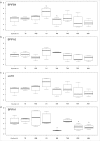Whole genome detection of sequence and structural polymorphism in six diverse horses
- PMID: 32271776
- PMCID: PMC7144971
- DOI: 10.1371/journal.pone.0230899
Whole genome detection of sequence and structural polymorphism in six diverse horses
Abstract
The domesticated horse has played a unique role in human history, serving not just as a source of animal protein, but also as a catalyst for long-distance migration and military conquest. As a result, the horse developed unique physiological adaptations to meet the demands of both their climatic environment and their relationship with man. Completed in 2009, the first domesticated horse reference genome assembly (EquCab 2.0) produced most of the publicly available genetic variations annotations in this species. Yet, there are around 400 geographically and physiologically diverse breeds of horse. To enrich the current collection of genetic variants in the horse, we sequenced whole genomes from six horses of six different breeds: an American Miniature, a Percheron, an Arabian, a Mangalarga Marchador, a Native Mongolian Chakouyi, and a Tennessee Walking Horse, and mapped them to EquCab3.0 genome. Aside from extreme contrasts in body size, these breeds originate from diverse global locations and each possess unique adaptive physiology. A total of 1.3 billion reads were generated for the six horses with coverage between 15x to 24x per horse. After applying rigorous filtration, we identified and functionally annotated 17,514,723 Single Nucleotide Polymorphisms (SNPs), and 1,923,693 Insertions/Deletions (INDELs), as well as an average of 1,540 Copy Number Variations (CNVs) and 3,321 Structural Variations (SVs) per horse. Our results revealed putative functional variants including genes associated with size variation like LCORL gene (found in all horses), ZFAT in the Arabian, American Miniature and Percheron horses and ANKRD1 in the Native Mongolian Chakouyi horse. We detected a copy number variation in the Latherin gene that may be the result of evolutionary selection impacting thermoregulation by sweating, an important component of athleticism and heat tolerance. The newly discovered variants were formatted into user-friendly browser tracks and will provide a foundational database for future studies of the genetic underpinnings of diverse phenotypes within the horse.
Conflict of interest statement
The authors have declared that no competing interests exist.
Figures


References
MeSH terms
Substances
LinkOut - more resources
Full Text Sources
Research Materials

